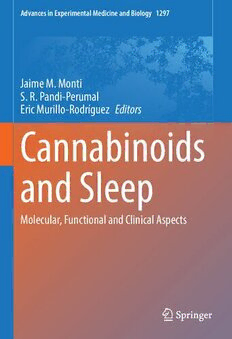
Cannabinoids and Sleep: Molecular, Functional and Clinical Aspects PDF
Preview Cannabinoids and Sleep: Molecular, Functional and Clinical Aspects
Advances in Experimental Medicine and Biology 1297 Jaime M. Monti S. R. Pandi-Perumal Eric Murillo-Rodríguez Editors Cannabinoids and Sleep Molecular, Functional and Clinical Aspects Advances in Experimental Medicine and Biology Volume 1297 SeriesEditors WimE.Crusio,InstitutdeNeurosciencesCognitivesetIntégratives d’Aquitaine,CNRSandUniversityofBordeaux, PessacCedex,France HaidongDong,DepartmentsofUrologyandImmunology, MayoClinic,Rochester,MN,USA HeinfriedH.Radeke,InstituteofPharmacology&Toxicology,Clinicofthe GoetheUniversityFrankfurtMain,FrankfurtamMain,Hessen,Germany NimaRezaei,ResearchCenterforImmunodeficiencies,Children'sMedical Center,TehranUniversityofMedicalSciences,Tehran,Iran JunjieXiao,CardiacRegenerationandAgeingLab, InstituteofCardiovascularSciences,SchoolofLifeScience, ShanghaiUniversity,Shanghai,China Advances in Experimental Medicine and Biology provides a platform for scientific contributionsinthe maindisciplines ofthe biomedicine and the life sciences.Thisseriespublishesthematicvolumesoncontemporaryresearchin the areas of microbiology, immunology, neurosciences, biochemistry, biomedicalengineering,genetics,physiology,andcancerresearch.Covering emergingtopicsandtechniquesinbasicandclinicalscience,itbringstogether cliniciansandresearchersfromvariousfields. Advances in Experimental Medicine and Biology has been publishing exceptionalworksinthefieldforover40years,andisindexedinSCOPUS, Medline (PubMed), Journal Citation Reports/Science Edition, Science Citation Index Expanded (SciSearch, Web of Science), EMBASE, BIOSIS, Reaxys, EMBiology, the Chemical Abstracts Service (CAS), and Pathway Studio. 2019ImpactFactor:2.450 5YearImpactFactor:2.324 Moreinformationaboutthisseriesathttp://www.springer.com/series/5584 (cid:129) (cid:129) Jaime M. Monti S. R. Pandi-Perumal Eric Murillo-Rodríguez Editors Cannabinoids and Sleep Molecular, Functional and Clinical Aspects Editors JaimeM.Monti S.R.Pandi-Perumal SchoolofMedicine SomnogenCanadaInc. UniversityoftheRepublic Toronto,ON,Canada Montevideo,Uruguay EricMurillo-Rodríguez DivisiónCienciasdelaSalud UniversidadAnáhuacMayab Merida,Mexico ISSN0065-2598 ISSN2214-8019 (electronic) AdvancesinExperimentalMedicineandBiology ISBN978-3-030-61662-5 ISBN978-3-030-61663-2 (eBook) https://doi.org/10.1007/978-3-030-61663-2 #SpringerNatureSwitzerlandAG2021 Thisworkissubjecttocopyright.AllrightsarereservedbythePublisher,whetherthewholeor part of the material is concerned, specifically the rights of translation, reprinting, reuse of illustrations,recitation,broadcasting,reproductiononmicrofilmsorinanyotherphysicalway, andtransmissionorinformationstorageandretrieval,electronicadaptation,computersoftware,or bysimilarordissimilarmethodologynowknownorhereafterdeveloped. Theuseofgeneraldescriptivenames,registerednames,trademarks,servicemarks,etc.inthis publication does not imply, even in the absence of a specific statement, that such names are exemptfromtherelevantprotectivelawsandregulationsandthereforefreeforgeneraluse. Thepublisher,theauthors,andtheeditorsaresafetoassumethattheadviceandinformationin thisbookarebelievedtobetrueandaccurateatthedateofpublication.Neitherthepublishernor the authors or the editors give a warranty, expressed or implied, with respect to the material containedhereinorforanyerrorsoromissionsthatmayhavebeenmade.Thepublisherremains neutralwithregardtojurisdictionalclaimsinpublishedmapsandinstitutionalaffiliations. ThisSpringerimprintispublishedbytheregisteredcompanySpringerNatureSwitzerlandAG. Theregisteredcompanyaddressis:Gewerbestrasse11,6330Cham,Switzerland “Cannabis is the most versatile herbal remedy, and the most useful plant on Earth. No other single plant contains as wide a range of medically active herbal constituents.” —Dr. Ethan Russo Cannabinoid Research Institute “The illegality of cannabis is outrageous, an impediment to full utilization of a drug which helps produce the serenity and insight, sensitivity and fellowship so desperately needed in this increasingly mad and dangerous world.” —Carl Sagan This volume is dedicated to our respective families. Foreword For most researchers, and certainly for the general population, “cannabis” relates totheplant and its constituents alone. However, since the mid-1980s andearly1990s,researchhasexpandedourknowledge.Today,thecannabi- noidfieldofsciencecoversthecannabinoidreceptors,theendocannabinoids (particularly anandamide and 2-AG), their synthetic and degradation pathways, and endogenous anandamide-like compounds, which are fatty acid amides with amino acids or ethanolamines. All these entities are parts ofamajornewphysiologicalsystem—theendocannabinoidone.Mostprob- ably,thefieldwillexpandfurther. Plant Cannabinoids While many dozens of plant cannabinoids are known today,mostresearchandacquiredknowledgeareonΔ9-tetrahydrocannabinol (THC)andcannabidiol(CBD).CBDwasisolatedinthe1930sinthelabsof AdamsintheUSAandToddintheUK,butitsstructurewaselucidatedmany years later—in 1963; THC was isolated in pure form, and its structure was elucidatedonlyin1964.Thesechemicaladvancesweremademanydecades aftertheisolationofmorphineandcocaine—thetwoothermajorillicitplant constituents. The reason for this discrepancy seems to be the technical diffi- cultyinisolating theplantcannabinoidsinpureform,duetothestupendous mixtureofthisfamilyofcompoundsproducedbytheplant.Modernmethods forseparationandpurificationnotavailablepreviouslywereneeded. In addition to THC and CBD, there are indications that cannabigerol (CBG)andpossiblycannabichromene(CBC)arelikewiseofmedicinalinter- est.Verylittleisknownabouttherestoftheplantcannabinoids,exceptonthe cannabinoid acids, which are the precursors of the neutral cannabinoids. These acids are not stable, which seems to be the main reason why their biologicalpropertieswerenotwellinvestigated.However,recentlyCBDacid wasstabilized(byesterificationtoitsmethylester).ItseemstoparallelCBD initsactions.Wealreadyknowthatitisapotentanti-nociceptive,antiemetic, andanxiolyticcompound.Shallweseeitinthemarket,likeCBD,inallkinds ofindustrial-preparedfoodsandbeautylotions?Ihopenot. Most“medicalcannabis”soldtodayisintheformofmixturesinwhichthe amountofspecificcannabinoidsvaries.Canweguesswhereweshallbewith such mixtures or pure cannabinoids in about a decade from now? Given the hugemarkettoday,themixtures,aswellaspureCBD,willprobablybestill around. However, we can expect to have better-defined mixtures, as well as ix x Foreword semi-syntheticCBDandCBGderivatives,asdrugsinmanyareas.Numerous pharmaceuticalcompanieshavecannabinoidprograms.Inadditiontothepain and anxiety mentioned above, we shall probably see synthetic and semi- synthetic cannabinoids in additional areas of psychiatry and neurology as wellas,presumably,ingastroenterologyandimmunology. EndogenousCannabinoids Thediscoveryofareceptorinthe1980sledto the isolation of endogenous cannabinoids (endocannabinoids) in the 1990s. Two of these, anandamide and 2-AG, have been the topic of thousands of publications. We have learned much about their chemistry, including the synthesis and degradation of these molecules in the animal body, as well as theirbioactivities.Theendocannabinoidsystemhasturnedouttobeacentral one in animal physiology. Indeed in a recent review, it was stated that “...modulating endocannabinoid activity may have therapeutic potential in almostalldiseasesaffectinghumans.”Eventhedopaminergicorcholinergic systemshavenotbeensodescribed. Whataretheresearchpathwaysaheadofusinthisarea? A. Will the endocannabinoids be investigated in humans? More than 25 years after their discovery human studies are almostunavailable! B. Shallweseeadditionalendocannabinoids,which have not been isolated so far? They may differ in their activity from anandamideand2-AG. C. Hastheactivityofendocannabinoidsbeenlooked intoinallanimalbiochemicalsystems? D. Do we know enough about the role of the endocannabinoidsinouremotionsandpersonality? E. Canweexpecttoseeendocannabinoidderivatives asdrugs? Anandamide-likeEndogenousMolecules Thebiosynthesisofanandamide is based on fatty acid (arachidonic acid) and amino acid derivatives (an ethanolamine). The animal body has numerous fatty acids and amino acids, andindeed,itusestheestablishedbiosyntheticpathwayofanandamideforthe synthesisofmanyadditional,chemicallyrelatedmolecules,mostofwhichdo not bind to the cannabinoid receptors. Over the last two decades, several groups have investigated these anandamide-like endogenous molecules. A fewexamplesofsuchcompounds(testedonlyinmiceandratssofar)areas follows: Arachidonoylserineisneuroprotectiveafterbraintrauma.Itcausesvasodila- tion,thusallowingbetterbloodflowintodamagedareas. Oleoyl serine acts on osteoblasts and prevents bone loss in osteoporosis by increasingboneformationandrestrainingboneresorption. Oleoyl glycine has powerful anti-nicotine addiction properties. It blocks the establishment of nicotine place preference—a test for addiction forma- tion—and reduces withdrawal responses in nicotine-dependent mice. In morphine-dependentrats,itwasalsofoundtoreducewithdrawalresponses butdidnotaffectmorphineaddiction,thusdemonstratingselectivity. Foreword xi These are just a few examples. Many other anandamide-like compounds are present in the animal body and act in numerous biological processes. Indeed,ithasbeenspeculatedthatthehugenumberofsuchcompounds—the concentration levels of which may differ from person to person—may be involvedinthepersonalitydifferences. Iwouldliketoendwithalookatthefutureofcannabinoiddrugs—asseen from afar. At present, most patients who use cannabinoid-based drugs are prescribed“medicalmarijuana”—atermthatfromamedicalpointofviewis unacceptable. “Medical marijuana” reaching the public has to be better defined as regards constituents, whose levels in many cases are not even mentioned. The level of constituents in cannabis depends to a large degree notonlyonthegeneticsoftheplantbutalsoontheconditionsunderwhichit wasgrown.Hence,todaytheconsumptionof“medicalmarijuana”istoalarge extent a medical gamble. As mentioned above, I believe that in most countries, within the next few years, strict regulations will be enacted, so that patients will always be able to get the same material as regards constituents. Asecondpoint—manyofthedrugsweusetodayarederivativesofnatural products.Thus,wehavenotprescribedcortisone(animportanthormone)but derivativesofcortisone.Suchderivativesarebettersuitedtobeusedasdrugs than natural constituents are. It seems reasonable to expect that within a decade pharmaceutical companies will develop derivatives of CBD and THC, and possibly CBG, which will be used as novel drugs. We may also have synthetic drugs, unrelated to the plant cannabinoids, which bind to the cannabinoidreceptor,particularlytotheCB2receptor,whoseactivationdoes notleadtomarijuana-likeactivity. In summary, I assume that within a decade we shall have both new cannabinoiddrugsandwell-definedextracts,usedinparallel.Letushopeso. HebrewUniversity,MedicalFaculty, RaphaelMechoulam,PhD PharmacySchool, InstituteforDrugResearch,Jerusalem,Israel
